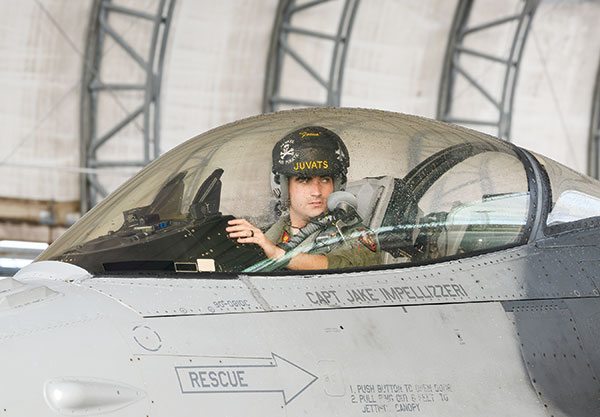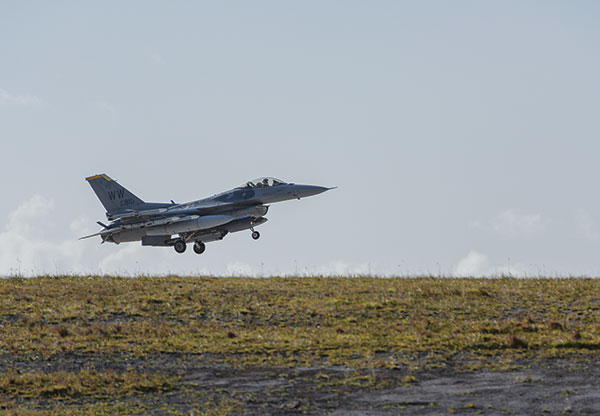Armed forces scatter across Pacific, then regroup in Guam

U.S. Air Force Capt. Mike Karnes, 14th Fighter Squadron F-16 fighter pilot, parks an F-16 Fighting Falcon at Andersen Air Force Base, Guam, last April 22, 2019, during Resilient Typhoon, an exercise designed to strengthen airpower dispersal capabilities within the Indo-Pacific region.
(U.S. AIR FORCE/SSG BRITTANY A. CHASE)
Pacific Air Forces airmen and aircraft from across the command joined together at Andersen Air Force Base in Guam last April 22 to participate in a dispersal exercise throughout Micronesia.
The exercise, named Resilient Typhoon, tests PACAF’s ability to execute flight operations from several locations in order to maintain readiness. It involved airmen and aircraft concentrated in one place, Andersen Air Force Base—separating via a dispersal, recovering, and then rapidly resuming operations at airports and airfields in Guam, Tinian, Saipan, Federated States of Micronesia, and Palau.
The exercise is designed to validate PACAF’s ability to adapt to rapidly developing events, like inclement weather, while maintaining readiness in support of allied and partner nations throughout the region.
Scheduled training activities included airfield rescue firefighting, post-disaster communications, and the rapid movement of people and cargo which share resources and foster interoperability.
“Operational environments and global threats evolve rapidly,” said Brig Gen Michael Winkler, PACAF director of strategy, plans and programs. “We must ensure that all forward-deployed forces are ready for a potential contingency with little notice and that we can move more fluidly across the theater to seize, retain and exploit the initiative in any environment.”
While Andersen serves as a premier power projection platform, a number of factors—to include weather—can influence how PACAF maneuvers and postures forces in the region.
Over the past year, the threat and impact of inclement weather has become increasingly relevant in the wake of typhoons that created training stoppages during the most recent iterations of both the Vigilant Shield and Cope North exercises in Guam.

A U. S. Air Force F-16 Fighting Falcon assigned to the 35th Fighter Wing, Misawa Air Base, Japan lands at Andersen Air Force Base, Guam, last April 22, 2019.
(U.S. AIR FORCE/SSG BRITTANY A. CHASE)
Units and aircraft participating in the Resilient Typhoon exercise included F-16s from Misawa Air Base, Japan’s 35th Fighter Wing; F-15C Eagles from Kadena Air Base, Japan’s 18th Wing; C-130Js from Yokota Air Base, Japan’s 374th Airlift Wing; C-17s and F-22s from Joint Base Pearl Harbor-Hickam’s 15th Wing and 154th Wing (Hawaii Air National Guard); and supplemental capabilities and personnel from the 36th Wing, Andersen AFB, and 3rd Wing, Joint Base Elmendorf-Richardson, Alaska.
Military forces routinely operate and train from and in the vicinity of Guam and the CNMI, as well as the FSM and Palau in support of a free and open Indo-Pacific.
“Pacific Air Forces appreciates the long history of support it has enjoyed in the region and strives to be a good partner with the people across Micronesia in support of a free and open Indo-Pacific,” Winkler said. “These exercises serve to enhance our relationships, while also providing invaluable training and operational readiness. Our airmen will be exercising innovative concepts with as light and agile a footprint as possible, while upholding the strictest safety and environmental standards.”
Static displays of the aircraft and interactions with the airmen operating and maintaining them were made available to the public.



























